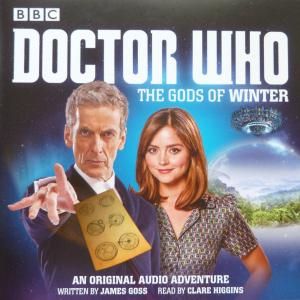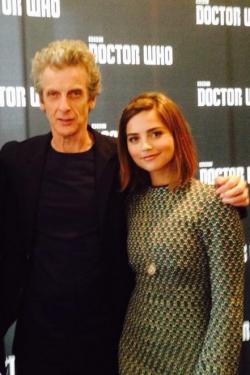Four Doctors #2
WRITER - PAUL CORNELL; ARTIST - NEIL EDWARDS
COLORIST - IVAN NUNES;
LETTERER - RICHARD STARKINGS AND JIMMY BETANCOURT; DESIGNER - ROB FARMER;
EDITOR - ANDREW JAMES;
ASSISTANT EDITOR - KIRSTEN MURRAY
RELEASED AUGUST 19TH 2015, TITAN COMICS
When last we encountered the Twelfth, Eleventh and Tenth Doctors as well as their newly united array of companions, the former trio had seemingly set a foreboding chain of events in motion by briefly touching hands and in doing so causing the (fictitious but no less intriguing) Blinovitch Limitation Effect to occur. Upon glimpsing the final pages of this audacious mini-series’ potent first issue, eagle-eyed readers might have recalled that this particular Time Vortex-damaging event last took place way back in “Father’s Day” as Rose made physical contact with her toddler self, and just as was the case in 2005, the ruthless Reapers made their return in Issue 1’s delightfully dense final panel to fix the wound caused by the three Time Lords’ near-unprecedented interaction.
Given the rarity of multi-Doctor serials of this ilk (lest we forget, ten years’ worth of interplanetary adventuring separated the broadcasts of “The Three Doctors” and its memorably nostalgic 1983 follow-up), that so much time is dedicated in “Four Doctors”’ second instalment to both the aforementioned Limitation Effect as well as the increasingly tense dynamic burgeoning between Capaldi’s ever-antagonistic incarnation and his former selves should really come as little surprise, especially since half of the reason why “The Day of the Doctor” met with such rapturous applause in 2015 was the fascinating interplay witnessed between Tennant, Smith and Hurt’s versions of the titular time traveller. With that being said, whilst few would likely blame the series’ commander-in-chief, Paul Cornell, for taking a “if it ain’t broke, don’t fix it”-style approach in this instance given the unquestionable need for works of comic-book and televisual entertainment to lure in a sizeable enough audience to make some form of profit, at the same time, that the second appearance of the oft-forgotten extra-terrestrial menaces who essentially caused Pete Tyler’s death acts more as a stalling tactic on the scribe’s part than anything else seems equally beyond dispute.
This initially well-disguised structural shortcoming makes its presence gradually known as Issue 2 nears its climax despite having made virtually no progress with regards to the series’ overall story arc of three morally contrasted Doctors joining forces to investigate the alleged repercussions of their Time War predecessor’s actions (or perhaps lack thereof) on the planet of Marinus. Certainly, we’re offered up some enticing sequences involving a chase through the various TARDIS console rooms which have made their debuts since the show’s revival as well as the continued squabbling provoked by the oldest of our three heroes’ continued rejection of his more spritely selves’ occasional recklessness and vice versa in the case of the Twelfth Doctor’s tendency to place his allies in necessary danger so as to achieve his goals. Yet aside from a few welcome moments wherein Tennant’s incarnation astutely namechecks the version of himself apparently set to rise between his twelfth and final bodies – see “The Trial of a Time Lord” if this description doesn’t ring any bells – and the classic series adversaries who cameoed last issue make their larger intentions transparently clear, it’s tough to shake the sense that either Cornell or those who assisted in his structuring of this much-anticipated Summer event struggled to find a way to keep its momentum up for four issues, hence the handy inclusion of the Reapers as an inspired yet nevertheless clunky means by which to stall for time. Indeed, that even Smith’s Doctor notes at one point how insignificant his pursuers are in terms of the trap apparently being laid for him and his other selves on Marinus does little to weaken this interpretation.
Even if “Four Doctors” doesn’t deploy quite as many satisfying plot twists or game-changing reveals here as was the case with its premiere, however, the number of readers who come away from Issue 2 wholly disappointed will still most likely be impressively minimal. The aforementioned TARDIS-warping set-piece and the frequent moments of verbal sparring between both the titular defenders of galactic justice as well as their companions – the most artistic of whom, the Tenth Doctor’s loyal accomplice Gabby Gonzalez, once again gets to open proceedings with a characteristically simplistic yet effortlessly visually sumptuous diary segment (as was the case in the first year of the Tenth and Gabby’s Titan Comics escapades) drawn wonderfully by Neil Edwards – which form the bulk of this instalment aren’t exactly the most innovative of scenes given that 2013’s “Day” placed a similarly substantial emphasis on such moments, but the inert hilarity of witnessing a variety of disparate heroes (both alien and human) attempt to put aside their differences whilst preparing for a universe-threatening conflict hasn’t waned in the two years since the 50th Anniversary Special first aired. If anything, the concept in question’s appeal has only grown with the releases of ensemble motion pictures like Marvel’s Avengers Assemble and Guardians of the Galaxy, both of which showcased the entertainment value of such encounters and thus likely pre-empted Titan’s thinking in creating this type of event series.
Whilst we’ve already touched upon the gloriously accomplished renditions of images such as Gabby’s diary and indeed Issue 1’s explosive last-minute Reaper reveal, in discussing this second outing’s easily overlooked merits, it’d be downright churlish to wrap up without having reiterated the undeniable power of Edwards’ aesthetic work. Like most works of science-fiction, “Four Doctors”’ fundamentally basic yet sure-to-be timey-wimey storyline requires one to pay no shortage of attention to the dialogue contained within its ever-present speech bubbles, that the Welsh artist responsible for bringing past hits like Justice League United and Arrow Season 2.5 to life through his imagery might leave some wishing the entirety of this four-issue arc could be re-released with only its artwork rather than its dialogue remaining says a lot for how he manages to convey precisely what’s occurring through his crowded but accessible visual depictions of events. Many modern Who strips would leave their readership most likely confounded were they to be robbed of textual accompaniments, yet based on the strength of Edwards’ work on this particular mini-series to date, Titan’s first major crossover storyline may well prove to be the single major exception to the unwritten rule.
Indeed, it’s through Edwards that Issue 2 manages to somehow claw its way back from the jaws of defeat so as to become another memorable addition to the plethora of comic-books based within the so-called Whoniverse. Had this otherwise largely derivative sophomore instalment not found itself an artist with such incredible creative vision, an artist capable of succinctly yet powerfully rendering both the action-led and exposition-heavy moments of “Four Doctors” with equal ease (and more importantly equal success), then there’s no doubt in this reviewer’s mind that this month’s tale – if not the series as a whole – would have suffered immensely as a result, but instead, in him we’ve been graced with someone capable of ensuring that even a more repetitive, arc-lite outing such as this one still brings almost all of the thrills and shocks present in its predecessor, at least from a visual perspective. Better yet, since Cornell’s next move going forwards will surely be to pick up the pace exponentially, chances are that Edwards will receive opportunities aplenty to showcase his seemingly limitless capabilities in issues to come, something which – at least based on the hugely promising evidence presented here – could only serve to benefit the overall reading experience that much more.









